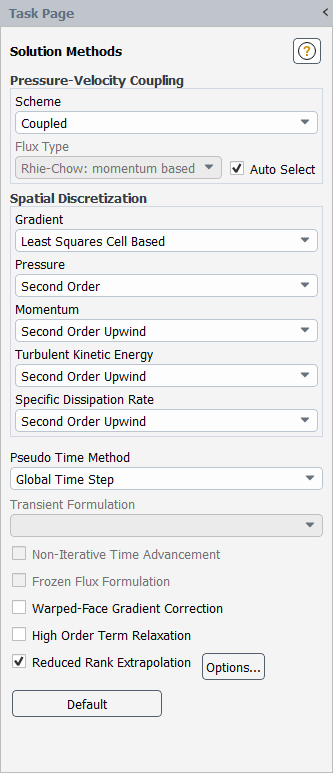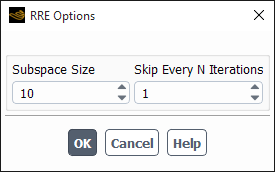The Reduced Rank Extrapolation method (RRE) is a technique used to accelerate the convergence of numerical methods involving nonlinear iterative solution algorithms. A Finite Volume simulation of the Navier-Stokes flow equations, as performed in Ansys Fluent, is such a method. Benefits of the application of RRE include better convergence rates, removal of residual stalling, and improved coupling between equations among different numerical models. The algorithm is independent of the type of flow solver and equally applicable to explicit, implicit, and pressure and density based algorithms. The drawback is an increased memory consumption.
The RRE method is representative of the set of so called Krylov type methods. Such methods
explore the idea originally proposed by Krylov [3] that the solution of
the linear system lies within the space defined as
(19–1) |
which is also known as the Krylov subspace.
The RRE method obtains a vector as a linear combination of orthogonal basis vectors
of
, which minimizes the Euclidian norm of the residual vector
. This is usually a better approximation
of the solution at the given iteration. A linear least squares procedure
is applied in order to solve the minimization problem. Due to the
memory requirements imposed by the need to keep solution vectors from
previous iterations in memory, only a limited subset of the entire
Krylov space
is stored. The method operates on that subset once the user specified
size
(i.e. number of nonlinear flow solver iterations)
is reached. Then a new subspace is populated with the solution vectors
from the following
iterations and subsequently the RRE procedure is
restarted. It was found that in certain cases it might be beneficial
to not store the solution vector at each iteration, but to skip a
certain number of iterations. This is because of the fact that two
subsequent solution vectors are almost linearly dependent and do not
provide much new information for the Krylov subspace. The number of
skipped iterations is also a user specifiable value.
Ansys Fluent’s RRE method operates simultaneously on a predefined
set of main flow variables, which are stored into a shared solution
vector and uses the regular flow solver as a preconditioner to generate
the products
.
It can be shown that when applied to a linear problem, the RRE method is equivalent to the GMRES method derived by Y. Saad and M. H. Schultz [6]. Details of the method as well as investigations of its behavior when applied to the Navier-Stokes problems can be found in [7] and [2].
Note: The Krylov subspace data is not written into the data file for reasons of keeping the file size small and the i/o times limited. A certain jump of residual values if a precomputed data is read into a new Ansys Fluent session is expected.
To use the Reduced Rank Extrapolation option, follow the steps outlined below:
Make sure you enable access to the beta features (Introduction).
In the Solution Methods task page, enable the Reduced Rank Extrapolation option.
Click the Options... button to specify the RRE settings in the RRE Options dialog box.
Specify the size of the subspace in the RRE Options dialog box.
Specify the number of iterations to skip while building it.
Note: In certain cases, it may be beneficial to increase the size of the Krylov subspace to 25 and store each 10th vector.
Run the solution.




